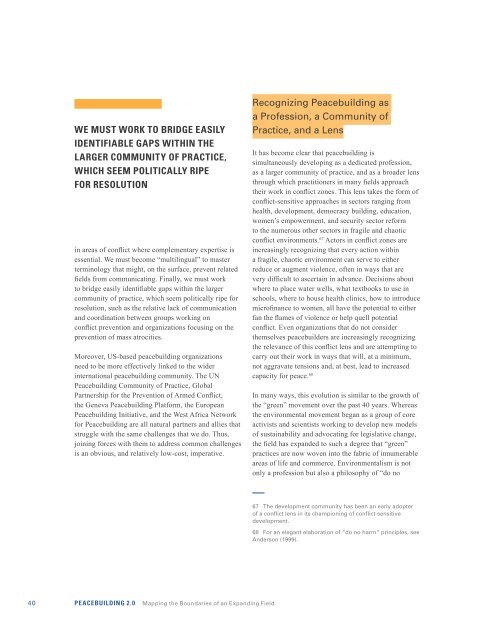Peacebuilding 2.0: Mapping the Boundaries of an Expanding Field
Peacebuilding 2.0: Mapping the Boundaries of an Expanding Field
Peacebuilding 2.0: Mapping the Boundaries of an Expanding Field
Create successful ePaper yourself
Turn your PDF publications into a flip-book with our unique Google optimized e-Paper software.
WE MUST WORK TO BRIDGE EASILY<br />
IDENTIFIABLE GAPS WITHIN THE<br />
LARGER COMMUNITY OF PRACTICE,<br />
WHICH SEEM POLITICALLY RIPE<br />
FOR RESOLUTION<br />
in areas <strong>of</strong> conflict where complementary expertise is<br />
essential. We must become “multilingual” to master<br />
terminology that might, on <strong>the</strong> surface, prevent related<br />
fields from communicating. Finally, we must work<br />
to bridge easily identifiable gaps within <strong>the</strong> larger<br />
community <strong>of</strong> practice, which seem politically ripe for<br />
resolution, such as <strong>the</strong> relative lack <strong>of</strong> communication<br />
<strong>an</strong>d coordination between groups working on<br />
conflict prevention <strong>an</strong>d org<strong>an</strong>izations focusing on <strong>the</strong><br />
prevention <strong>of</strong> mass atrocities.<br />
Moreover, US-based peacebuilding org<strong>an</strong>izations<br />
need to be more effectively linked to <strong>the</strong> wider<br />
international peacebuilding community. The UN<br />
<strong>Peacebuilding</strong> Community <strong>of</strong> Practice, Global<br />
Partnership for <strong>the</strong> Prevention <strong>of</strong> Armed Conflict,<br />
<strong>the</strong> Geneva <strong>Peacebuilding</strong> Platform, <strong>the</strong> Europe<strong>an</strong><br />
<strong>Peacebuilding</strong> Initiative, <strong>an</strong>d <strong>the</strong> West Africa Network<br />
for <strong>Peacebuilding</strong> are all natural partners <strong>an</strong>d allies that<br />
struggle with <strong>the</strong> same challenges that we do. Thus,<br />
joining forces with <strong>the</strong>m to address common challenges<br />
is <strong>an</strong> obvious, <strong>an</strong>d relatively low-cost, imperative.<br />
Recognizing <strong>Peacebuilding</strong> as<br />
a Pr<strong>of</strong>ession, a Community <strong>of</strong><br />
Practice, <strong>an</strong>d a Lens<br />
It has become clear that peacebuilding is<br />
simult<strong>an</strong>eously developing as a dedicated pr<strong>of</strong>ession,<br />
as a larger community <strong>of</strong> practice, <strong>an</strong>d as a broader lens<br />
through which practitioners in m<strong>an</strong>y fields approach<br />
<strong>the</strong>ir work in conflict zones. This lens takes <strong>the</strong> form <strong>of</strong><br />
conflict-sensitive approaches in sectors r<strong>an</strong>ging from<br />
health, development, democracy building, education,<br />
women’s empowerment, <strong>an</strong>d security sector reform<br />
to <strong>the</strong> numerous o<strong>the</strong>r sectors in fragile <strong>an</strong>d chaotic<br />
conflict environments. 67 Actors in conflict zones are<br />
increasingly recognizing that every action within<br />
a fragile, chaotic environment c<strong>an</strong> serve to ei<strong>the</strong>r<br />
reduce or augment violence, <strong>of</strong>ten in ways that are<br />
very difficult to ascertain in adv<strong>an</strong>ce. Decisions about<br />
where to place water wells, what textbooks to use in<br />
schools, where to house health clinics, how to introduce<br />
micr<strong>of</strong>in<strong>an</strong>ce to women, all have <strong>the</strong> potential to ei<strong>the</strong>r<br />
f<strong>an</strong> <strong>the</strong> flames <strong>of</strong> violence or help quell potential<br />
conflict. Even org<strong>an</strong>izations that do not consider<br />
<strong>the</strong>mselves peacebuilders are increasingly recognizing<br />
<strong>the</strong> relev<strong>an</strong>ce <strong>of</strong> this conflict lens <strong>an</strong>d are attempting to<br />
carry out <strong>the</strong>ir work in ways that will, at a minimum,<br />
not aggravate tensions <strong>an</strong>d, at best, lead to increased<br />
capacity for peace. 68<br />
In m<strong>an</strong>y ways, this evolution is similar to <strong>the</strong> growth <strong>of</strong><br />
<strong>the</strong> “green” movement over <strong>the</strong> past 40 years. Whereas<br />
<strong>the</strong> environmental movement beg<strong>an</strong> as a group <strong>of</strong> core<br />
activists <strong>an</strong>d scientists working to develop new models<br />
<strong>of</strong> sustainability <strong>an</strong>d advocating for legislative ch<strong>an</strong>ge,<br />
<strong>the</strong> field has exp<strong>an</strong>ded to such a degree that “green”<br />
practices are now woven into <strong>the</strong> fabric <strong>of</strong> innumerable<br />
areas <strong>of</strong> life <strong>an</strong>d commerce. Environmentalism is not<br />
only a pr<strong>of</strong>ession but also a philosophy <strong>of</strong> “do no<br />
67 The development community has been <strong>an</strong> early adopter<br />
<strong>of</strong> a conflict lens in its championing <strong>of</strong> conflict-sensitive<br />
development.<br />
68 For <strong>an</strong> eleg<strong>an</strong>t elaboration <strong>of</strong> “do no harm” principles, see<br />
Anderson (1999).<br />
40 PEACEBUILDING <strong>2.0</strong> <strong>Mapping</strong> <strong>the</strong> <strong>Boundaries</strong> <strong>of</strong> <strong>an</strong> Exp<strong>an</strong>ding <strong>Field</strong>


